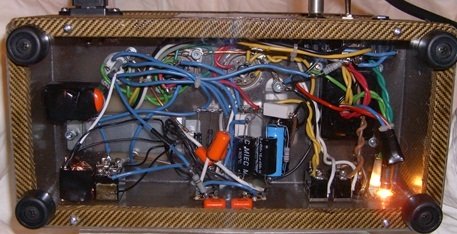|
Amp Lead Dress
One of the first terms I saw was "amp lead dress", when I got interested in building electric guitar amps. I thought it was pronounced like the metal, instead it's like "lead a horse to water". One of the reasons that you and I can build a better amplifier than we can buy, is because we have the ability to pay particular attention to detail. One of those details is running wires through the amplifier in such a way, that the ambient noise, or quiescent noise (HUM), is almost non-existent. When wiring an amplifier it is of particular importance to keep low power signal wires, such as the wires from tone pots, grids from pre-amp/power amp tubes, or the in jack of the guitar, as far away from high power wires as possible. In addition proper amp lead dress dictates all power wires, and all wires in pairs for that mater, should be run in a twisted format. For high power AC wires like the line in, secondaries out of the power transformer, etc. the twisted format helps cancel EMF's (electro magnetic fields)that would otherwise bleed into the signal wires and create noise. Running twisted pairs also keeps things neat, even though rectified DC contributes less EMF's. When designing the layout of an amp I always try to make sure my high power wires are on one side or end of the amp, and that low power signal wires are at the other end or side. Sometimes, like in wiring up a tube socket, you have high power, and signal wires, close to one another. I always keep filament or heater wires on the same plane(shown as green wires in the picture if you can see them), and signal wires (Shown as blue wires) at a different plane, and always at right angles to one another. Always cross low power signal wires and high power wires at right angles, and separate them as much as possible. A small distance, 1/2" is huge because magnetic fields decrease logarithmically, with distance. There is much information to learn about proper lead dress at the Weber Amp website forum. As important is proper grounding techniques which I'll get into on another page. Thanks for reading, and please email me any questions, J.B. 3-20-11
return from return from Amp Lead Dress to Electric Guitar Info home |
If you have any questions regarding electric guitar modifications, building, setup, amplifiers, etc. send me an email .....Guitarinfo145@aol.com..... All questions are appreciated, and often lead to new ideas for additional content. I do my best to get back as soon as possible, Thanks, J.B.




